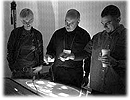Interactions: Description

Photo Credits
More than just papers, MW2005 offers a chance for dialogue.
| Workshops |
| Sessions |
| Speakers |
| Interactions |
| Demonstrations |
| Exhibits |
| Best of the Web |
| produced by
|
| Join our Mailing List Privacy Policy |
Real Science: Making Connections to Research and Scientific Data
Jim Spadaccini, Ideum, USA
Mini-Workshop: Live Data and Visualisation
Originally developed as tool to help scientists share information, the World Wide Web continues to be an important mode of communication for scientific inquiry. Rich science datasets in a variety of fields are publicly available, and can provide a unique catalyst for learning. Science Centers can act as mediators; organizing information across scientific disciplines and providing tools for understanding
complex scientific research. Users can gain a unique insight into the scientific process and Science Centers can do what they do best—make science understandable and interesting to the public. Physical exhibits work well in showing scientific phenomenon but not necessarily the scientific process. Most exhibits due to their physical nature cannot be converted into effective online experiences.
They tend to be pale cousins of their physical counterparts—"virtual" exhibits in the worst sense of the word. Developing online resources that mine datasets from "real" scientific endeavors can help explain the scientific process with a unique relevancy. Furthermore these types of resources can provide a link, both actual and metaphoric, to the scientific community.
This "mini-workshop" will examine the technical aspects of incorporating datasets, including real-time images. We’ll even take a brief look at incorporating XML/RSS data and news feeds. Our focus will be on Macromedia Flash, which has emerged as a powerful tool to present these types of datasets and to allow users to manipulate them. However, much more important than the technical aspects, we’ll look at the content questions and design considerations involved in utilizing these types of data in public Websites and exhibits. After all, scientific datasets are produced for scientists, not for the general public. How these data are presented and mediated for public audiences is an essential question in creating successful education resources. We’ll examine several examples and methods for developing interpretive tools and resources.
April 2005
analytic scripts updated:
October 2010
Telephone: +1 416 691 2516 | Fax: +1 416 352 6025 | E-mail:
